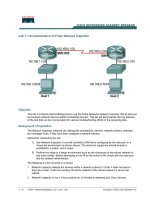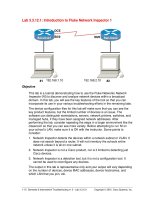Introduction to Fluke Protocol Inspector 2
Bạn đang xem bản rút gọn của tài liệu. Xem và tải ngay bản đầy đủ của tài liệu tại đây (513.57 KB, 20 trang )
1-20 Semester 8 Internetwork Troubleshooting v1.0 - Lab 3.3.12.2 Copyright 2001, Cisco Systems, Inc.
Lab 3.3.12.2: Introduction to Fluke Protocol Inspector 2
SanJose1 SanJose2
#2#1
S0/0
S0/0
DCE
192.168.1.10 192.168.2.10
Objective
This lab is a tutorial demonstrating how to use the Fluke Networks Protocol
Inspector (PI) to analyze network traffic and data frames. In this lab you will see
the key features of the tool so that you can incorporate its use in your various
troubleshooting efforts in the remaining labs.
The output in this lab is representative only and your output will vary depending
on the number of devices added, device MAC addresses, device hostnames,
and which LAN that you join, etc.
Scenario
This lab introduces the Protocol Inspector, which you may find useful in later
troubleshooting labs and in the field. While the Protocol Inspector (PI) software
is a valuable part of the Academy program, it is also representative of features
available on other products in the market.
Note: The configuration file used for this lab will be used for other module 2
labs, so please do not change any configuration settings. The configuration
contains several components for testing purposes and is not intended to
represent a good production configuration.
At least one the hosts must have the Protocol Inspector software installed. If
the lab is done in pairs, having the software installed on both machines means
that , person can run the lab steps, albeit each host may display slightly
different results.
2-20 Semester 8 Internetwork Troubleshooting v1.0 - Lab 3.3.12.2 Copyright 2001, Cisco Systems, Inc.
Step 1
Note: This is exactly the same lab configuration as the Network Inspector lab.
Cable the lab as shown in the diagram.
Load the configuration files Lab3-SanJose1Config.txt and Lab3-
SanJose2Config.txt into the appropriate routers.
Configure the workstations as follows (same as the last lab):
Host #1 Host #2
IP Address: 192.168.1.10 IP Address: 192.168.2.10
Subnet mask: 255.255.255.0 Subnet mask: 255.255.255.0
Default Gateway: 192.168.1.1 Default Gateway: 192.168.2.1
Step 2
From the Start menu, launch the Fluke Protocol Inspector EDV program.
Note: The first time the
program is run a message will
appear that asks: “Do you
have any Fluke analyzer
cards or Fluke taps in your
local system?”
If you are using the
educational version, click on
No. If you answer yes or if the
following screen appears, just
click on OK without selecting
any ports.
There are four main Protocol Inspector views including:
• Summary View
• Detail View
• Capture View of Capture Buffers
• Capture View of Capture Files
The program opens in the Summary View. This view shows several windows
used by the tool. The Resource Browser window in the upper left corner
3-20 Semester 8 Internetwork Troubleshooting v1.0 - Lab 3.3.12.2 Copyright 2001, Cisco Systems, Inc.
shows the only monitoring device that we have: the NDIS 802.3 Module (NIC)
of the host. If there were Protocol Media Monitors, they would be displayed with
the associated host devices. The Alarm Browser (left side) and Message
Area (bottom) will be covered later.
The Monitor View (main window – upper right) monitors one resource per
window in a variety of viewing options. The example below and probably the
startup screen shows no information in the Monitor View window (the Stop in
the upper-left corner of the Monitor View window confirms that no monitoring is
occurring).
Resource Browser
Message Area
Monitor View
NIC
Step 3
To start the monitoring / capturing process use the Start button or Module |
Start from the menu system. The Utilization chart should start showing activity
like this:
4-20 Semester 8 Internetwork Troubleshooting v1.0 - Lab 3.3.12.2 Copyright 2001, Cisco Systems, Inc.
The word
ARM
should appear where Stop had been before. If you open the
Module
menu, you will see that Stop is now an option, while Start is muted.
Don’t stop the process yet, or at least restart it again if you do.
The tabs at the bottom of the window show the resulting data in a variety of
forms. Click on each and note the results (transmit
Tx
,
Alarms,
and
Alarm Log
will be blank). The following is the Received (
Rx
) frames which indicates that
Broadcast
and
Multicast
frames are being received, but may not show any
Unicasts
.
Using the console connection to the router, ping the monitoring host
(192.168.1.10 or 192.168.2.10) and you will see
Unicast
frames appear.
Unfortunately, the errors shown in the second and third column will not appear
in our lab exercise unless you can add a traffic generator like Fluke Networks
OptiView product.
5-20 Semester 8 Internetwork Troubleshooting v1.0 - Lab 3.3.12.2 Copyright 2001, Cisco Systems, Inc.
The
Description
tab
reveals the MAC
address,
manufacturer and
model of the NIC. It
also shows which
Error Counters are
on.
Take a few minutes
to become familiar
with the tabs and the
scroll features of the
window.
Step 4
To access the
Detail View
window click on the detail view button in the
toolbar or double click anywhere on the Monitor View chart. This will open a
second window that should look something like the following - after maximizing
the
Utilization / Errors Strip Chart (RX)
window.
6-20 Semester 8 Internetwork Troubleshooting v1.0 - Lab 3.3.12.2 Copyright 2001, Cisco Systems, Inc.
Note:
If necessary, activate all toolbars on the View menu.
Initially, the chart output is the same as before, but there are many more toolbar
and menu options than in the Summary View. Before we look at these features
confirm that the Chart and Table tabs show the same information that we saw
earlier.
Like all Windows compliant programs, placing the mouse over a button brings
up a screen tip briefly identifying the button’s purpose. As you move the mouse
over the buttons, you will notice that some are muted-meaning that the feature
is not appropriate under current circumstances or in some cases not supported
on the educational version.
Note:
There is a complete display of the toolbars and what they do in the
Appendix at the end of this lab.
Click on the
Mac Statistics
button to see the Rx frame table data displayed
in another format. The result should be obvious. Maximize the resulting
window. The one piece of new information is the
Speed:
showing the NIC
transmission rate.
Click on the
Frame Size Distribution
button to see a distribution of the
size frames being received by the NIC. Placing the mouse over any bar will
display a small summary like the one shown below. Maximize the resulting
window.
7-20 Semester 8 Internetwork Troubleshooting v1.0 - Lab 3.3.12.2 Copyright 2001, Cisco Systems, Inc.
Try the Pie, Bar, and Pause buttons in the upper-left corner.
Note:
Pause
stops the capture, so click on it again to resume the capture. Look at both the
Table and Chart tab displays as well.
With our sample configurations you should be getting mainly small frames, but
then the only thing happening is routing updates. You might try using the
extended Ping feature from the router Console connection and specify 100
pings with a larger packet size.
If you have been maximizing each new display, you can return to any previous
view by using the Window menu. You can also
Tile
the windows. Experiment
with the Window menu features and then close any unwanted views.
8-20 Semester 8 Internetwork Troubleshooting v1.0 - Lab 3.3.12.2 Copyright 2001, Cisco Systems, Inc.
Click on the
Protocol Distribution
button to see a distribution of the
protocols being received by the NIC. Placing the mouse over any bar will
display a small summary panel. Maximize the resulting window.
Try each of the buttons and tabs to see the results. The
Net
button shows only
network protocols. The
323
button refers to the H323 Voice Over IP protocols.
Look at the
Frm
(frame) and the
Abs Bts
(absolute bytes) and
Rel Bts
(relative
bytes) to see the results. Remember that the
Pause
button stops the capture.
Click on the
Host Table
button to see the MAC stations and related traffic.









